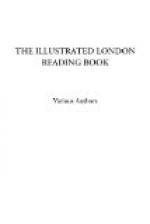There hope in the Ark at the
dawning of day,
When o’er the wide waters
the Dove flew away;
But when ere the night she
came wearily back
With the leaf she had pluck’d
on her desolate track,
The children of Noah knelt
down and adored,
And utter’d in anthems
their praise to the Lord.
Oh bird of glad tidings! oh
joy in our pain!
Beautiful Dove! thou art welcome
again.
When peace has departed the
care-stricken breast,
And the feet of the weary
one languish for rest;
When the world is a wide-spreading
ocean of grief,
How blest the return of the
Bird and the Leaf!
Reliance on God is the Dove
to our Ark,
And Peace is the olive she
plucks in the dark.
The deluge abates, there is
sun after rain—
Beautiful Dove! thou art welcome
again!
MACKAY.
[Illustration: SYRIAN DOVE.]
* * * * *
COBRA DI CAPELLO—HOODED SNAKE.
[Illustration: Letter T.]
There are several varieties of this venomous serpent, differing in point of colour; and the aspic of Egypt, with which Cleopatra destroyed herself, is said to be a very near ally to this species; but the true cobra is entirely confined to India.
The danger which accompanies the bite of this reptile, its activity when excited, the singularity of its form, and the gracefulness of its action, combine to render it one of the most remarkable animals of the class to which it belongs. When in its ordinary state of repose the neck is of the same diameter as the head; but when surprised or irritated, the skin expands laterally in a hood-like form, which is well known to the inhabitants of India as the symptom of approaching danger. Notwithstanding the fatal effects of the bite of these serpents, the Indian jugglers are not deterred from capturing and taming them for exhibition, which they do with singular adroitness, and with fearful interest to the unpractised observer. They carry the reptiles from house to house in a small round basket, from which they issue at the sound of a sort of flute, and execute certain movements in cadence with the music.
The animal from which our Engraving was taken is now in the menagerie of the Zoological Society in the Regent’s Park, and is probably one of the finest which has ever reached England alive.
The Indian mangouste is described to be the most deadly enemy of the cobra di capello, and the battles between them have been frequently described. The serpent, when aware of the approach of the mangouste, rises on its tail, and with neck dilated, its head advanced, and eyes staring, awaits with every look of rage and fear the attack of its foe. The mangouste steals nearer and nearer, and creeping round, endeavours to get an opportunity of springing on the serpent’s back; and whenever it misses its purpose and receives a bite, it runs perhaps some distance, to eat the mangouste-grass, which is an antidote against the poison: it then returns to the attack, in which it is commonly victorious.




